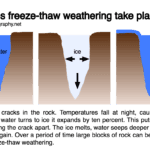Ever heard of Earth’s magnetic field flipping? It’s called a geomagnetic reversal, and it’s not quite the Hollywood disaster movie you might imagine. Think of it more like a really slow, complex process with some potentially serious consequences, mainly for our technology. This isn’t something to panic about, but it *is* something scientists are closely watching. We’ll explore what causes these flips, what happened in the past, and what could happen if it were to occur again. We’ll even look at a weird area called the South Atlantic Anomaly, where the magnetic field is already weaker than normal. We’ll discuss potential impacts on things we rely on every day—like power grids and GPS—and what’s being done to prepare for this possibility. It’s a story about our planet’s past, present, and future all wrapped up in a fascinating magnetic mystery.
Magnetic Pole Reversal: What It Is and Why It Matters
LSI Keywords: Geomagnetic reversal, Earth’s magnetic field, magnetic north, paleomagnetism
Imagine a compass spinning wildly, pointing in completely the wrong direction. That’s the essence of a magnetic pole reversal – a complete flip of Earth’s magnetic north and south poles. While it sounds like something out of a science fiction movie, it’s a natural phenomenon that’s happened countless times throughout our planet’s history. Understanding this process, its potential impacts, and the ongoing scientific debate surrounding it is crucial. But what exactly causes this phenomenon, and should we be concerned about its potential effects on our modern technology?
Earth’s Shielding and the Mysterious Geodynamo
LSI Keywords: Geodynamo, Earth’s core, solar radiation, magnetic field protection
Our planet is cocooned in a protective magnetic field, a giant, invisible bubble generated deep within the Earth’s core. This “shield” is created by the churning, swirling movements of molten iron – a process scientists call the geodynamo. The geodynamo is essentially a self-sustaining dynamo powered by the Earth’s internal heat. As hot, less dense material rises and cooler, denser material sinks within the liquid outer core, it creates electric currents that, in turn, produce the magnetic field. This magnetic field deflects harmful solar radiation and charged particles that constantly bombard our planet. Think of it as a cosmic armor, safeguarding life as we know it. However, this magnificent shield isn’t static; it’s dynamic and has flipped its polarity numerous times throughout Earth’s long history.
Unlocking the Secrets of the Past: Paleomagnetism
LSI Keywords: Paleomagnetism, geological records, rock formations, magnetic timeline
How do we know magnetic reversals have happened? The answer lies in the Earth itself. Rocks, as they form, essentially act like tiny tape recorders, preserving the direction and strength of the magnetic field at the time of their creation. Iron-rich minerals in cooling lava align themselves with the magnetic field’s direction, providing a snapshot of the field’s orientation at that moment. This “paleomagnetism” provides a fascinating glimpse into the past. Scientists study these ancient magnetic records in rocks, building a timeline of past reversals stretching back millions of years. The timing of these flips is unpredictable; sometimes they occur relatively quickly, within a few centuries, while other times, the process drags on for millennia. More than 180 full reversals are known over the past 83 million years alone.
Our Wobbly Compass: Current Magnetic Field Behavior
LSI Keywords: Magnetic north pole migration, South Atlantic Anomaly, magnetic field weakening
Currently, our magnetic field is acting a little strange. The magnetic north pole, far from being a stable point, is migrating rapidly across the Arctic, moving faster than at any point in recorded history. It’s racing towards Siberia at a rate of nearly 55 kilometers per year. This isn’t just a minor shift; it’s a noticeable change suggesting underlying activity within the Earth’s core. Furthermore, there’s the South Atlantic Anomaly, a vast region where the magnetic field is significantly weaker. In this area, cosmic rays and solar radiation penetrate closer to Earth’s surface, posing a potential threat to satellites and even affecting the reliability of our navigation systems. Could these fluctuations indicate that we are entering a period of increased instability in our magnetic field?
Potential Consequences: A Look at the Impacts
LSI Keywords: Solar radiation exposure, satellite disruption, power grid failure, wildlife migration
So, is a full-blown magnetic pole reversal imminent? That’s the million-dollar question scientists are actively working to answer. While there’s no evidence to suggest a reversal itself will cause a mass extinction (life has adapted through past reversals), the consequences of a weakened magnetic field could be significant. A less potent shield means less protection against harmful solar radiation and increased exposure to charged particles that can wreak havoc on our technological infrastructure.
Let’s break down the potential impacts:
- Technology Takes a Hit: Satellites could experience malfunctions or even catastrophic failure due to increased radiation exposure.
- Increased Radiation Exposure: People living at higher latitudes could be exposed to increased levels of radiation.
- Power Grid Vulnerabilities: Geomagnetically induced currents (GICs) during solar storms could overload power grids, causing widespread blackouts.
- Wildlife’s Inner Compass: Migratory animals could lose their sense of direction due to a weakened or altered field.
The Great Debate: Uncertainties and Ongoing Research
LSI Keywords: Geodynamo modeling, scientific consensus, reversal timing, intensity prediction
While the evidence of past reversals is irrefutable, pinpointing the timing and intensity of the next one remains a major challenge. The geodynamo is incredibly complex, and our ability to model it accurately is still under development. There’s a lively debate among scientists about when (or even if) a complete reversal will occur. Some experts suggest it may happen within the next few centuries, while others believe it could be millennia away. The relationship between the current weakening of the magnetic field and an eventual full reversal remains an area of intense investigation. Given the uncertainty, what steps are scientists taking to monitor and understand these complex phenomena?
Monitoring, Adaptation, and International Collaboration
LSI Keywords: Observatories, computer modelling, satellite shielding, international cooperation
Scientists are actively monitoring the Earth’s magnetic field using a global network of observatories. These observatories collect data on the field’s strength and direction, providing valuable insights into its behavior. They are striving to improve our understanding of the geodynamo through advanced computer modeling and new data analysis techniques. This research is not merely academic; it’s essential for predicting potential disruptions and preparing for them. Technologies are being developed to enhance satellite shielding, improve power grid resilience, and develop backup navigation systems. International cooperation is crucial for sharing data, coordinating research efforts, and preparing for the potential impact of a magnetic reversal on a global scale.
A Table Summarizing Potential Impacts (Simplified)
| Area Affected | Potential Impact | Mitigation Strategies |
|---|---|---|
| Satellites | Damage from radiation, orbital decay | Improved shielding, redundant systems |
| Power Grids | Voltage fluctuations, blackouts | Enhanced protection, grid modernization |
| Navigation Systems | Reduced accuracy, signal disruptions | Redundant systems, improved algorithms |
| Communication Systems | Signal interference | Backup systems, alternative communication methods |
| Wildlife Navigation | Disruption of migration patterns | Further research needed |
Looking Ahead: The Need for Continued Vigilance
LSI Keywords: Gradual process, technological advancements, mitigation, resilience
A magnetic pole reversal is not a simple on/off switch. It’s a gradual process, likely spanning decades or even centuries. While a complete reversal may bring challenges, humanity has shown remarkable adaptability throughout history. Continued research, improved monitoring, and proactive technological advancements will be crucial in mitigating the potential disruptions. By better understanding the nuances of this complex phenomenon, we can better prepare for the future. The ongoing scientific investigation is vital not only for enhancing our knowledge but also for ensuring our safety and resilience in the face of this natural process.
How will a weakening magnetic field impact satellite technology during a pole reversal?
LSI Keywords: Satellite technology, radiation damage, data loss, GPS disruption
Our planet’s magnetic field, a protective shield against harmful solar radiation, is weakening. This isn’t just some minor fluctuation; it’s a significant event with potentially far-reaching consequences. And one of the most pressing concerns? The impact on our increasingly reliant satellite technology.
What’s Happening to Earth’s Magnetic Field?
LSI Keywords: Geodynamo, magnetic pole wandering, South Atlantic Anomaly, magnetic field strength
Earth’s magnetic field is generated by the movement of molten iron in our planet’s core – a process called the geodynamo. Think of it as a giant, natural dynamo. This field has flipped its poles numerous times throughout history, with the north and south magnetic poles swapping places. While these reversals typically take thousands of years, the current weakening is raising concerns. The North Magnetic Pole is wandering at an unprecedented speed, and the South Atlantic Anomaly, a region with a significantly weaker magnetic field, continues to expand. The field’s strength has dropped by about 10 percent over the past 160 years, and satellite data suggests that parts of it are thinning at an even faster rate, particularly over the South Atlantic Ocean.
The South Atlantic Anomaly: A Sneak Peek into the Future?
LSI Keywords: SAA, radiation exposure, single-event upsets, satellite malfunctions
The South Atlantic Anomaly (SAA) is a region where the magnetic field is considerably weaker than the global average. This allows more energetic particles from the sun to penetrate the atmosphere, potentially impacting satellites passing through this area. Satellites orbiting within the SAA experience increased radiation exposure, leading to malfunctions. Single-event upsets (SEUs) are common, causing temporary glitches or even permanent damage to sensitive electronics. Imagine it as a hole in Earth’s magnetic umbrella.
How will a weakening magnetic field impact satellite technology during a pole reversal?
LSI Keywords: Solar particle penetration, electronic damage, system failure, radiation-hardened technology
During a full geomagnetic reversal, the weakening effect will be significantly amplified. This increased solar radiation exposure will affect various satellite systems:
- Increased radiation damage: More solar particles penetrate the atmosphere, damaging sensitive satellite electronics and potentially shortening their lifespan.
- Data loss and corruption: Radiation can corrupt data being transmitted or stored on board.
- System malfunctions: critical systems may fail entirely due to radiation-induced damage. The effects range from temporary glitches to complete system failures.
What About GPS and Other Navigation Systems?
LSI Keywords: Compass-based navigation, GPS accuracy, ground-based systems, radio signal disruption
A weakened magnetic field directly impacts compass-based navigation systems. While GPS primarily relies on signals from satellites, a significant magnetic field weakening could potentially disrupt the systems’ accuracy for ground-based systems. Think of it like trying to navigate with a faulty compass in a magnetic storm – not ideal. Furthermore, Increased solar activity accompanying a reversal can disrupt radio signals used for communication and navigation. These disruptions can affect aviation, maritime transport, and even everyday smartphone navigation.
What Can We Do?
LSI Keywords: Radiation-resistant components, redundant systems, space weather forecasting, satellite shielding
The good news is we’re not helpless. We can prepare for these challenges. For example, we can start investing heavily in the following areas:
- Radiation-hardened technology: Designing satellites with radiation-resistant components can mitigate the impact of increased solar radiation.
- Redundant systems: Incorporating backup systems ensures continuous operation even if primary systems fail due to radiation damage.
- Improved space weather forecasting: More accurate predictions are needed to anticipate the severity of magnetic storms and take preventive measures. This includes investment in advanced monitoring systems and research into solar activity.
- Satellite Shielding: Enhancing satellite shielding can provide additional protection against radiation exposure.
Key Takeaways:
LSI Keywords: Geomagnetic reversal risks, enhanced technology, forecasting, mitigation strategies
- Earth’s magnetic field is weakening and shifting, a process that has happened before.
- A geomagnetic reversal, while not imminent, poses technological risks.
- How will a weakening magnetic field impact satellite technology during a pole reversal? Increased radiation exposure will damage electronics, lead to data loss and malfunctions, and increase maintenance costs.
The South Atlantic Anomaly: A Critical Concern and its Implications for Technological Infrastructure
LSI Keywords: Weakened magnetic field, satellite infrastructure, westward drift, mitigation strategies
Key Takeaways:
- The South Atlantic Anomaly (SAA) is a region of weakened magnetic field strength, exhibiting unusual behavior.
- This weakening poses growing risks to satellites and other technological infrastructure.
- Constant monitoring and adaptive strategies are crucial for safeguarding technological assets.
Understanding Earth’s Shielding
LSI Keywords: Bar magnet analogy, solar radiation protection, geodynamo process, magnetic field uniformity
Imagine Earth as a giant bar magnet, its magnetic field acting as a protective shield against harmful solar radiation. This field is generated deep within our planet’s core, a process called the geodynamo. But this shield isn’t uniform; it has weak spots, and one particularly significant area is The South Atlantic Anomaly: A Critical Concern and its Implications for Technological Infrastructure.
The SAA: A Growing Problem
LSI Keywords: Magnetic field reduction, satellite radiation, low-intensity zones, anomaly expansion
The SAA is a region where the magnetic field is significantly weaker than average. Think of it as a dent in Earth’s protective magnetic bubble. Satellites passing through this area experience higher levels of radiation, potentially leading to malfunctions. Recent observations reveal the anomaly is not only weakening but also expanding and even splitting into two distinct low-intensity zones. The anomaly’s center is also drifting westward, further complicating its impact on satellite orbits. How does this evolving anomaly impact satellite operations and the reliability of our technological systems?
Impacts on Technology
LSI Keywords: Single-event upsets, data corruption, system failures, geomagnetic storm effects
The increased radiation exposure within the SAA isn’t just a theoretical concern. Satellites experience single-event upsets (SEUs), which are essentially glitches caused by high-energy particles. These glitches can lead to data corruption, system failures, and even complete satellite malfunction. Navigation systems and power grids could also be affected during severe geomagnetic storms, though to a lesser extent than space-based systems. The aviation industry, especially in polar routes, could also be affected by increased radiation.
Is this a sign of a pole reversal?
LSI Keywords: Pole reversal prediction, Earth’s core dynamics, timeline uncertainties, long-term consequences
While the SAA’s behavior is concerning, it’s important not to jump to conclusions. A full magnetic pole reversal, where the north and south magnetic poles swap places, is a different, albeit related, phenomenon. While the SAA’s unusual behavior provides valuable data on the dynamics of the Earth’s core, it doesn’t definitively predict an immediate pole flip. The timeline for a full reversal is uncertain, and the long term consequences are still under investigation. Some scientists believe that the weakening and expansion of the SAA could be an early sign of a pole reversal, while others caution that it could be a natural fluctuation.
What’s being done?
LSI Keywords: Enhanced radiation tolerance, trajectory refinement, advanced monitoring, data sharing
Space agencies are working diligently: improving satellite designs for enhanced radiation tolerance, refining satellite trajectories to minimize exposure, and investing in advanced monitoring systems. International collaboration and data sharing are crucial for developing better predictive models and informed mitigation strategies. We need to enhance our understanding of the Earth’s core processes and the mechanisms driving changes in the magnetic field like the SAA. This includes investing in research into the geodynamo and the factors that influence its behavior.
Looking Ahead
LSI Keywords: Proactive measures, continuous research, international cooperation, space-based systems resilience
The South Atlantic Anomaly: A Critical Concern and its Implications for Technological Infrastructure highlights the need for proactive measures. Continuous monitoring, research, and international cooperation are essential to mitigate the risks posed by this evolving anomaly. Ignoring this growing concern could have significant implications for our technological reliance on space-based systems. The future depends on our ability to understand and adapt to the dynamic nature of Earth’s magnetic field.
Preparing for a Geomagnetic Reversal: Essential Steps for Protecting Critical Infrastructure
LSI Keywords: Geomagnetic reversal preparation, infrastructure protection, solar storm vulnerability, proactive approach
Key Takeaways:
- Geomagnetic reversals are a natural phenomenon with documented occurrences throughout Earth’s history.
- The current weakening magnetic field increases vulnerability to solar storms.
- A proactive, multi-faceted approach is required to protect critical infrastructure.
What’s Happening to Earth’s Magnetic Field?
LSI Keywords: Earth’s magnetism, solar radiation shield, South Atlantic Anomaly, magnetic field reduction
Imagine Earth as a giant bar magnet. Its magnetic field protects us from harmful solar radiation. But this shield is weakening! The South Atlantic Anomaly, a region with a significantly weaker field, is a prime example. Scientists are observing a decrease in the field’s strength over recent centuries. Is a complete magnetic pole flip imminent? What does this mean for our reliance on technology? The Earth’s magnetic field has decreased in strength by approximately 10-15% over the last 150 years.
Geomagnetic Reversals: A Look Back in Time
LSI Keywords: Geological records, magnetic orientation, reversal process, erratic pole movement
Earth’s magnetic poles have flipped countless times. Geological records, like the magnetic orientation locked within rocks, provide clear evidence. These reversals aren’t sudden events; they happen over hundreds or even thousands of years. The process involves a weakening field, potentially erratic pole movement, and an eventual reversal. During a reversal, the magnetic field can weaken to as little as 10% of its normal strength.
The Current Situation: A Weakened Shield
LSI Keywords: South Atlantic Anomaly, reduced protection, satellite radiation, northward migration
The magnetic field’s weakening isn’t just theoretical. We’re seeing it happen now. The South Atlantic Anomaly is a tangible demonstration. This region experiences reduced magnetic protection, leading to increased radiation exposure for satellites and even affecting some airplane electronics. The northward migration of the magnetic north pole is another striking indicator. While we can’t definitively predict when a full reversal will happen, the current changes are undeniable. The magnetic North Pole is currently moving at a rate of 10 to 40 kilometers per year. In recent decades, that movement has accelerated dramatically.
What Could a Weakened Field Mean for Us?
LSI Keywords: Solar radiation damage, power grid overload, blackout risk, wildlife migration disruption
A weaker field isn’t just a scientific curiosity; it poses significant risks. Increased solar radiation could damage satellites. Geomagnetically Induced Currents (GICs) from solar storms could overload power grids, causing widespread blackouts. Navigation systems relying on magnetic fields could become unreliable. Migratory animals that rely on the Earth’s magnetic field for navigation could be disoriented.
Addressing the Challenge: Preparing for a Geomagnetic Reversal: Essential Steps for Protecting Critical Infrastructure
LSI Keywords: Infrastructure hardening, resilient satellites, international data sharing, public awareness
We need a multi-pronged strategy:
- Improved Infrastructure: Hardening power grids to better withstand GICs is crucial. This includes upgrading transformers and implementing real-time monitoring systems.
- Technological Advancements: Developing more resilient satellites and navigation systems is essential. This includes using radiation-hardened components and redundant systems.
- International Collaboration: Sharing data and research findings is critical. This includes establishing international standards for infrastructure protection and coordinating research efforts.
- Public Awareness: Educating the public about the potential risks and the steps being taken to mitigate them is essential.
- Enhanced Space Weather Forecasting: Improving our ability to predict solar storms is crucial for providing early warnings and allowing for preventative measures to be taken.
Uncertainties and Ongoing Research
LSI Keywords: Reversal timing debates, consequence investigation, continuous monitoring, preparedness improvement
While the potential impacts are clear, some questions remain unanswered. Scientists are still debating the exact timing of a future pole reversal, and the precise severity of the consequences is still under investigation. Continued research and monitoring are essential to refine our understanding and improve our preparedness. This includes investing in advanced computer modeling of the geodynamo and developing new technologies for monitoring the Earth’s magnetic field.
- Unlocking Ada Lovelace’s Secret: The First Computer Programmer’s Vision - July 31, 2025
- Revolutionizing Knowledge: The Printing Press and a New Age - July 31, 2025
- Unlock Da Vinci’s Genius: To-Do Lists Revealed - July 31, 2025
















